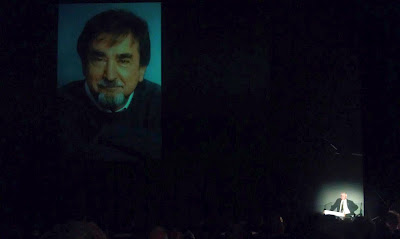|
|
 
|
|
Author
|
Topic: Roman Kroitor has passed away
|
Joseph L. Kleiman
Master Film Handler
Posts: 380
From: Sacramento, CA
Registered: Apr 2005
|
 posted 09-18-2012 12:45 AM
posted 09-18-2012 12:45 AM




From the National Film Board of Canada --
Montreal, Canada (Sept. 17, 2012) /CNW Telbec/ -- Canadian and world cinema has lost a true giant, with the death yesterday of film pioneer and former NFB colleague Roman Kroitor.
Born on December 12, 1926, in Yorkton, Saskatchewan, Kroitor made enormous contributions to filmmaking during his tenure at the NFB in the 1950s and 1960s, developing the IMAX giant-screen format at the NFB's Montreal studio.
"Roman Kroitor was a remarkable man who has made out-sized contributions to cinema as a filmmaker, producer and creative and technical innovator. He was a legend whose relentless pace of inventiveness continued throughout a long and productive career. His death is a terrific loss to the NFB, Canada and the world of cinema," said Tom Perlmutter, Government Film Commissioner and NFB Chairperson.
Kroitor was a leading light in direct cinema and the new documentary approaches that would put the NFB and Canadaat the forefront of a revolution in audiovisual storytelling, with works such as Paul Tomkowicz: Street-railway Switchman and the Candid Eye series.
His creative partnerships with Wolf Koenig and Colin Low resulted in some of the NFB's most acclaimed documentaries of all time, including Glenn Gould - On & Off the Record, Lonely Boy, Stravinsky and Universe. Asa producer, Kroitor was involved in the development of fiction films at the NFB, starting with Don Owen's landmark 1964 feature Nobody Waved Goodbye.
Kroitor also played a role in the creation of the Star Wars concept "The Force." Director George Lucas was an admirer of the work of NFB experimental filmmaker Arthur Lipsett and has credited a conversation between Kroitor and artificial intelligence pioneer Warren S. McCulloch, excerpted in Lipsett's 1963 collage film 21-87, as part of his inspiration.
It was his collaboration on the groundbreaking multi-screen project In the Labyrinth for Expo 67 in Montreal that would set the stage for a new chapter in Kroitor's life―as well as a new era in cinema.
Co-directed by Kroitor with Colin Low and Hugh O'Connor, and co-produced with Tom Daly, In the Labyrinth was an immersive cinema experience that caused a sensation at the Montreal world's fair, during Canada's centennial year. That same year, Kroitor chose to leave the NFB to further develop the process he helped pioneer with In the Labyrinth in the private sector, co-founding Multi-Screen Corporation.
But it was a single-projector giant-screen system that held the most promise for Roman. Co-inventing the IMAX film system and forming IMAX Corporation, Kroitor and his team set about redefining the possibilities of cinema.
The NFB remained very much a part of that creative development, with the NFB's Montreal HQ serving as the birthplace for the new medium. The very first IMAX film in 1970, Tiger Child, made for the Osaka world's fair, was directed by Donald Brittain. In the years to come, the NFB worked with Kroitor and Imax on such breakthroughs as the first IMAX 3D film, Transitions, and first IMAX HD film, Momentum, both directed for the NFB by Colin Low and Tony Ianzelo.
Kroitor returned to the NFB for several years beginning in the mid-1970s to head dramatic productions, producing such acclaimed works as Giles Walker's Bravery in the Field and John N. Smith's First Winter.
Most recently, the NFB and Kroitor were again creative partners, as the NFB animation studio, led by animator Munro Ferguson, developed new creative applications for IMAX Corporation's hand-drawn 3D stereoscopic animation technique, SANDDE.
Roman is survived by his wife Janet and children Paul, Tanya, Lesia, Stephanie and Yvanna.
| IP: Logged
|
|
|
|
Dave Macaulay
Film God

Posts: 2321
From: Toronto, Canada
Registered: Apr 2001
|
 posted 01-03-2013 02:40 PM
posted 01-03-2013 02:40 PM




Tiger Child was the first "Imax" film (it was actually Multiscreen Corporation then) but it was part of ... well, a multiscreen presentation. While still interesting, it really doesn't make any sense without the other screens or the environs of the Expo 70 pavilion it was made for, and it's pretty hard to watch with several dark stretches where other projectors would have been showing images on the screen. There are only very few full screen shots , most of it is the multiple image optical effect shown above. The full screen images were an experiment since a 15/70 camera had been developed although the company's focus then was on multiscreen optical production, a few short segements of full frame was shot for Tiger Child - a closeup of a pregnant womans navel for example.
Actually it's kinda traditional for Japanese Expo films to make little sense, but Tiger Child excelled at obscure meaning. I can guess that the title refers to the thalidomide children featured in a few scenes but I'm probably wrong. Other than that I can't figure out what's going on in it or imagine any continuity.
Roman was a colleague for many years, I enjoyed working with him and especially the occasions we hung out together at various odd places around the world.
Roman and Graeme Furgeson worked on a multiscreen project at Expo 67 (Labyrinth), and wanted a way to simplify the process which required several film projectors, sound dubber, and slide projectors to be synchronized - plus the fact that after Expo 67 closed the project would never be seen again bothered them. They came up with the idea of optically combining the film images on one large format frame, eliminating the troublesome selsyn lock between multiple film projectors. They brought in Bill Shaw, a mechanical engineer at the CCM bicycle company, to design the projector.
If Tiger Child had been made the "old" way, we could screen the various image elements separately (if they were archived) but not "married" without huge difficulty.
Roman was instrumental in selling the 15/70 idea to Fuji Group for their Expo 70 pavilion. With no real Multiscreen office (the projector development was done in a small shop in Galt, Ontario) Roman entertained the undecided Fuji executives at the Montreal National Film Board complex where he had an office (Roman made quite a few NFB films). Supposedly the Fuji group decided that Multiscreen was a reliable and reputable company because they had such a large busy office and studio complex, and they signed the contract.
Anyway, Roman will be missed by many people in many walks of life.
| IP: Logged
|
|
|
|
All times are Central (GMT -6:00)
|
|
Powered by Infopop Corporation
UBB.classicTM
6.3.1.2
The Film-Tech Forums are designed for various members related to the cinema industry to express their opinions, viewpoints and testimonials on various products, services and events based upon speculation, personal knowledge and factual information through use, therefore all views represented here allow no liability upon the publishers of this web site and the owners of said views assume no liability for any ill will resulting from these postings. The posts made here are for educational as well as entertainment purposes and as such anyone viewing this portion of the website must accept these views as statements of the author of that opinion
and agrees to release the authors from any and all liability.
|

 Home
Home
 Products
Products
 Store
Store
 Forum
Forum
 Warehouse
Warehouse
 Contact Us
Contact Us




 Printer-friendly view of this topic
Printer-friendly view of this topic










